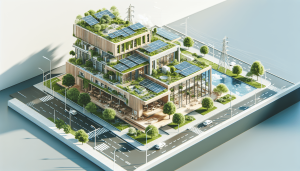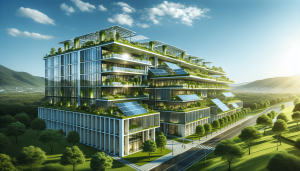In our journey towards a more sustainable future, it’s essential to understand how the materials we choose in architecture affect our environment. Sustainable architecture, at its core, aims to minimize negative environmental impacts, and the building materials we select play a pivotal role in this mission. From the extraction process to manufacturing, transportation, and eventual disposal, each stage has its own set of environmental consequences. In this article, we will explore these impacts and discuss how making informed choices can help us build more eco-friendly structures, ensuring a healthier planet for generations to come. Have you ever wondered about the environmental impacts of the materials we use to construct our buildings? As we shift towards more sustainable architecture, this question becomes increasingly significant.
In our quest for sustainability, the choices we make in building materials can either contribute to the problem or be part of the solution. Let’s dive deep into the environmental impacts of building materials in sustainable architecture, explore the different options available, and understand how they align with our goals for a greener planet.

What Are the Environmental Impacts of Building Materials?
Before we discuss the specifics, it’s essential to understand the general environmental impacts that building materials can have. Here’s a broad breakdown:
Resource Depletion
Many conventional building materials rely heavily on non-renewable resources. Mining and extracting these materials, such as minerals and fossil fuels, leave a significant dent in the planet’s finite resources.
Energy Consumption
The production, transportation, and disposal of building materials consume energy, often derived from non-renewable sources like coal and natural gas. This energy use contributes substantially to global greenhouse gas emissions.
Pollution
Chemical processes involved in the manufacture of many building materials lead to pollution. This includes air pollution from emissions, water pollution from runoff, and soil contamination.
Waste Generation
A considerable portion of construction waste ends up in landfills, contributing to the growing waste management crisis. Inefficient use of materials and demolition activities are major culprits.
Habitat Destruction
The extraction and production of building materials often result in the destruction of natural habitats, affecting ecosystems and biodiversity.
Now that we have an overview, let’s delve into the specifics of various building materials and how they influence sustainable architecture.
Categories of Building Materials
There are several broad categories of building materials, each with its own set of environmental impacts. We can classify them into three main groups:
- Natural Materials
- Processed Materials
- Synthetic Materials
Natural Materials
Natural materials are derived directly from nature with minimal processing. Examples include wood, bamboo, and straw. Their environmental impacts vary widely:
Wood
Wood is a renewable resource if harvested sustainably. However, unsustainable logging practices lead to deforestation and loss of biodiversity. Sustainable forest management and certification, such as FSC (Forest Stewardship Council), help mitigate these impacts.
Environmental Impacts of Wood:
| Impact | Description |
|---|---|
| Carbon Sequestration | Wood stores carbon, reducing greenhouse gases |
| Resource Depletion | Unsustainable logging leads to deforestation |
| Habitat Preservation | Sustainable practices protect ecosystems |
| Waste Generation | Low, as wood can be recycled or biodegraded |
Bamboo
Bamboo is one of the fastest-growing plants and can be a highly sustainable building material. It requires little water and can grow in a variety of climates, making it an excellent alternative to wood.
Environmental Impacts of Bamboo:
| Impact | Description |
|---|---|
| Rapid Renewal | Grows quickly, renewable over short cycles |
| Carbon Sequestration | Effective in storing carbon |
| Minimal Land Use | Requires less space and resources |
| Waste Generation | Low, biodegradable and recyclable |
Processed Materials
Processed materials undergo significant industrial treatment to be used in construction. Common examples include concrete, steel, and brick.
Concrete
Concrete is ubiquitous in modern construction. However, its environmental impacts are substantial, primarily due to the production of cement, its key ingredient.
Environmental Impacts of Concrete:
| Impact | Description |
|---|---|
| High Energy Use | Cement production is energy-intensive |
| CO2 Emissions | Significant greenhouse gas emissions |
| Resource Depletion | Requires large quantities of sand and gravel |
| Waste Generation | Demolition creates substantial waste |
Steel
Steel is another critical material in construction, known for its strength and durability, but its production carries considerable environmental burdens.
Environmental Impacts of Steel:
| Impact | Description |
|---|---|
| High Energy Use | Energy-intensive production processes |
| CO2 Emissions | Significant greenhouse gas emissions |
| Resource Depletion | Relies on finite mineral resources |
| Recycling Potential | High, reducing overall waste |
Synthetic Materials
Synthetic materials are man-made, often derived from chemical processes. They include plastics, composites, and synthetic insulation.
Plastics
Plastics are widely used in construction due to their versatility and durability. However, their environmental impacts are concerning.
Environmental Impacts of Plastics:
| Impact | Description |
|---|---|
| Non-renewable | Made from petroleum-based products |
| Pollution | Production and disposal cause significant pollution |
| Recycling Challenges | Difficult to recycle effectively, leading to waste |
| Long Degradation | Can take hundreds of years to break down |
Sustainable Alternatives and Innovations
As awareness of environmental impacts grows, so does innovation in sustainable building materials. Let’s explore some of the promising alternatives:
Recycled Materials
Using recycled materials in construction reduces waste and resource consumption. Examples include recycled steel, reclaimed wood, and recycled concrete aggregate.
Benefits of Recycled Materials:
| Benefit | Description |
|---|---|
| Waste Reduction | Diverts materials from landfills |
| Resource Conservation | Reduces demand for virgin materials |
| Energy Savings | Often requires less energy than producing new materials |
| Reduced Emissions | Lowers greenhouse gas emissions |
Green Concrete
Green concrete incorporates industrial by-products such as fly ash, slag, and silica fume, reducing the environmental footprint of traditional concrete.
Benefits of Green Concrete:
| Benefit | Description |
|---|---|
| Waste Utilization | Uses industrial by-products |
| Lower Emissions | Reduces CO2 footprint compared to traditional concrete |
| Durability | Can have enhanced properties like durability |
| Resource Efficiency | Uses less raw materials |
Hempcrete
Hempcrete is a bio-composite material made from the inner fibers of the hemp plant mixed with a lime-based binder. It is gaining popularity for its sustainability and versatility.
Benefits of Hempcrete:
| Benefit | Description |
|---|---|
| Carbon Sequestration | Absorbs CO2 during hemp growth |
| Renewable Resource | Made from rapidly growing hemp |
| Insulation Properties | Excellent thermal and acoustic insulation |
| Non-Toxic | Free from harmful chemicals |
Straw Bale
Straw bale construction uses bales of straw as structural elements, insulation, or both. It’s an ancient technique experiencing a revival due to its sustainability.
Benefits of Straw Bale:
| Benefit | Description |
|---|---|
| Renewable Resource | Utilizes agricultural by-products |
| Insulation Efficiency | High thermal and acoustic insulation properties |
| Waste Reduction | Diverts straw from becoming waste |
| Low Embodied Energy | Minimal processing required |
Life Cycle Assessment (LCA)
To truly understand the environmental impacts of building materials, we must consider their entire life cycle. Life Cycle Assessment (LCA) is a comprehensive method that evaluates materials from extraction to disposal.
Stages of LCA
- Extraction: Assessing the environmental impact of raw material extraction.
- Production: Evaluating the energy and emissions involved in processing and manufacturing.
- Transportation: Considering the environmental costs of transporting materials to the construction site.
- Use: Analyzing the material’s performance and maintenance requirements during its lifespan.
- End-of-Life: Examining the disposal, recycling, or repurposing options.
Example of LCA Components for Concrete:
| Stage | Environmental Impact |
|---|---|
| Extraction | Mining limestone, clay, and other raw materials |
| Production | Energy-intensive cement manufacturing |
| Transportation | Emissions from transporting heavy materials |
| Use | Maintenance and repair over the building’s lifespan |
| End-of-Life | Demolition waste, potential for recycling |
Conducting LCAs helps us make informed choices by highlighting the environmental trade-offs of different materials.

Sustainable Design Principles
Incorporating sustainable building materials is just one aspect of sustainable architecture. Several design principles work hand-in-hand to achieve environmental sustainability.
Energy Efficiency
Designing buildings to be energy-efficient reduces their overall environmental impact. This includes optimized insulation, natural lighting, and energy-efficient HVAC systems.
Water Conservation
Using materials and technologies that conserve water, such as low-flow fixtures and rainwater harvesting systems, helps in reducing the building’s water footprint.
Indoor Air Quality
Choosing non-toxic, low-emission building materials improves indoor air quality, contributing to healthier living and working environments.
Renewable Energy Integration
Incorporating renewable energy sources like solar panels and wind turbines in building design supports sustainable energy use.
Local Sourcing
Using locally sourced materials reduces transportation emissions and supports local economies.
Policy and Regulations
Governments and organizations play a crucial role in promoting the use of sustainable building materials through policies and regulations. Here are some examples:
LEED Certification
Leadership in Energy and Environmental Design (LEED) is a globally recognized certification that sets standards for environmentally responsible construction. It evaluates buildings on sustainability criteria, including material use.
BREEAM
Building Research Establishment Environmental Assessment Method (BREEAM) is another certification assessing the environmental performance of buildings. It emphasizes sustainable material selection.
National Regulations
Many countries have national regulations promoting sustainable building practices. For example:
- Energy Codes: Regulations mandating energy efficiency in building design.
- Green Building Standards: Guidelines for using eco-friendly materials.
- Incentives: Financial incentives for adopting sustainable practices.
Implementing these policies ensures broader adoption of sustainable building materials and practices.

Challenges and Barriers
Despite the progress in sustainable building materials, several challenges remain:
Cost
Sustainable materials can be more expensive upfront, deterring some builders and developers. However, long-term savings in energy and maintenance can offset these costs.
Availability
Not all sustainable materials are readily available everywhere, making it challenging to source them locally in some regions.
Awareness
A lack of awareness and understanding of sustainable materials among builders, architects, and consumers can slow their adoption.
Performance Concerns
Skepticism about the performance and durability of some sustainable materials can hinder their acceptance in mainstream construction.
Future Trends
The future of sustainable building materials looks promising, with ongoing research and development driving innovation. Here are some emerging trends:
Biodegradable Materials
Researchers are developing materials that break down naturally at the end of their lifecycle, reducing waste and pollution.
Smart Materials
Smart materials that respond to environmental changes can enhance building performance, such as self-healing concrete and adaptive insulation.
Circular Economy
Adopting circular economy principles in construction emphasizes recycling, reusing, and repurposing materials to minimize waste.
New Technologies
Advancements in 3D printing and nanotechnology are opening new possibilities for creating sustainable, customized building materials.
Conclusion
As we move towards a more sustainable future, the choice of building materials plays a critical role in shaping the environmental impacts of architecture. By understanding the nuances of natural, processed, and synthetic materials, we can make informed decisions that align with our sustainability goals. Embracing sustainable alternatives, conducting comprehensive Life Cycle Assessments, and adhering to best practices in sustainable design and policy frameworks can collectively pave the way for greener, more sustainable buildings.
So let’s continue to explore, innovate, and advocate for building materials that not only meet our construction needs but also nurture and protect our planet for generations to come. Together, we can build a more sustainable world, one material at a time.



